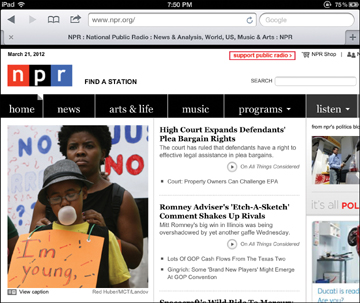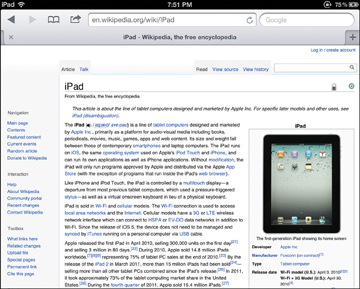- Writing and Printing on the iPad
- Writing Apps: Notes
- Writing Apps: Pages
- Awesome Apps
- Using the Internet for Homework
Using the Internet for Homework
If you’re using your iPad for schoolwork, you’ll probably use the Internet to do research for your papers. If you’re going to do that, though, there are a few things you need to know.
How to Do Research Online
It might seem obvious, but doing research for your schoolwork online works pretty much the same way that finding any other information does. If you don’t know where to find what you’re looking for, begin by searching for it at a search engine such as Google and tapping the sites that come up in the search results. If you know of websites that have the information you want, you can also go directly to them.
Of course, online isn’t the only place to do research. Your school or neighborhood library is packed full of helpful books and magazines. Ask your parents to take you there and then get help from the librarian to find what you’re looking for. Libraries are full of things you can’t get online at all. You never know what you’ll find at them—and that’s pretty cool!
Choosing Good Sources
The places you find information for your school papers are called sources. Books, encyclopedias, and even websites can all be sources.
Creating a website or blog is pretty easy. But because it’s so easy, that means just about anybody can do it—and not everyone is an expert on the things they’re writing about. When you’re writing papers for school, you should use only the best and most expert sources, not just the first ones you find.
But with so many websites online, how can you figure out who’s an expert? Here are some tips:
- Be skeptical—This means you shouldn’t automatically believe everything you read. A smart way to try to figure out if something is true is to check to see whether other websites are saying the same thing about the same topic. If they are, that means it’s more likely to be true.
- Use established sources—If you’re writing about a news story, going to a big-name news website such as CNN, CBS, or NPR is good idea. They’ll usually have more accurate information than the blog of a person who isn’t directly involved with what they’re writing about.
- Use primary sources—A primary source is someone with first-hand experience of a situation. For instance, if you’re writing about the Declaration of Independence, quoting writing by someone who helped write it or the Declaration itself are both great primary sources. If you’re writing about a person, quoting their own words is a terrific primary source.
- Consider the source—When deciding whose information to use in your paper, figure out who’s saying it. If you’re writing about biology, quoting a college biology professor is a better idea than quoting some random person with a blog but no expertise in biology.
- Watch out for Wikipedia—Wikipedia seems like an easy place to get all the information you need, but it’s not always accurate. That’s because almost anyone can change articles on Wikipedia, even if the changes they make are wrong. When using Wikipedia, find the information you’re looking for and then click the little number after the sentence or paragraph you want to use. This shows you where that information came from. Go to that site to confirm the information for yourself. If there’s no link, try finding the same information somewhere else to make sure it’s correct.
Using Research in Your Papers
When you find something that you want to use in your paper, don’t just copy and paste it. It’s important to give credit to the person who wrote what you want to use. If you don’t, and act like their words are your own, you’re committing plagiarism, which is a form of lying. If you wrote something and someone else used it, you’d want them to give you credit, right? You should do the same for others. When you find something you want to add to your paper, do the following:
- Always make sure to put the text you’re copying and pasting into your paper in quotes.
- Make sure to accurately write down who wrote the text you’re quoting and where they wrote it or where you found it.
- After the quotes, put the writer and the name of their work in parentheses. Italicize the name of the work.
- For example, if you’re quoting something written by Ben Franklin in a book called Ben Franklin Writes About American History (which I made up), and the quote is “American history is interesting,” you should write the following:
- “American history is interesting” (Ben Franklin, Ben Franklin Writes About American History).
- If you’re getting the quote from a website, try this:
- “American history is interesting” (Ben Franklin, www.benfranklin.com).
- Even if you’re not directly copying and pasting something from another document, it’s a good idea to give the writer credit for their ideas, as in the following example:
- Ben Franklin wrote that American history is interesting (www.benfranklin.com).
- Your teachers might have another way they want you to credit the sources you’re quoting. If they do, use their guidelines instead.
If you always follow these rules when you’re writing your papers, you won’t run the risk of getting in trouble for plagiarism and will establish writing habits that can help you succeed in school for years to come.

